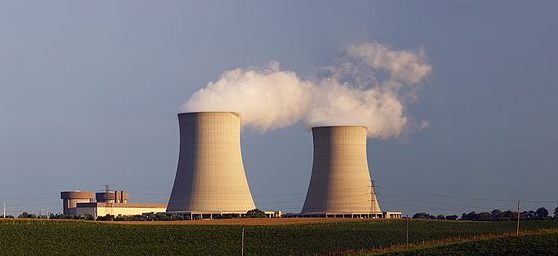New York City is set to ban gas hookups in new buildings, effectively requiring all-electric heating and cooking. The move could influence how cities around the world seek to reduce the burning of fossil fuels. https://t.co/E6EtznjOl6
— NYT Metro (@NYTMetro) December 16, 2021
Thursday, August 29, 2024
Wednesday, August 28, 2024
Tuesday, August 27, 2024
Monday, August 26, 2024
Friday, August 23, 2024
Halliburton experiences cyberattack at campus in Houston, Texas
(WO) – Halliburton, a major U.S. oil field services firm, experienced a cyberattack on Wednesday, affecting some of its systems, particularly at its north Houston campus and global connectivity networks, Reuters reported.
Citing an emailed press release and unnamed sources close to the matter, Reuters says Halliburton is investigating the incident and working with external experts to resolve it. Some employees have been asked not to connect to internal networks.
Although details about the Halliburton attack are unclear, ransomware typically involves hackers encrypting data and demanding payment in exchange for a decryption key. If the ransom is not paid, hackers may threaten to leak sensitive information.
Halliburton provides drilling equipment and services to major oil and gas companies around the world. With nearly 50,000 employees globally, the company has a presence in over 70 countries.
This story was originally reported by Reuters.
Wednesday, August 21, 2024
Tuesday, August 20, 2024
Monday, August 19, 2024
Friday, August 16, 2024
As US Coal Plants Shutter, a Renewed Focus on Nuclear ‘We’ll need an additional 200 gigawatts of nuclear capacity to reach net-zero emissions by 2050,’ the Energy Department stated.

https://www.theepochtimes.com/article/as-us-coal-plants-shutter-a-renewed-focus-on-nuclear-5704112
As the United States continues its rush to shutter the nation’s remaining coal plants, energy analysts are debating what should fill the gap to meet the growing need for electricity. Increasingly, many are pointing to nuclear energy as the solution.
This is happening as demand from data centers, electric vehicles, electric home heating, and othproducts are pushing ever more consumption onto the grid.
The agency, North American Electric Reliability Corporation (NERC), cited “clear evidence of growing resource adequacy concerns over the next 10 years” in its December 2023 Long-Term Reliability Assessment
https://www.theepochtimes.com/article/as-us-coal-plants-shutter-a-renewed-focus-on-nuclear-5704112
The rapid retirement of functional coal plants, which generated more than 16 percent of U.S. electricity production in 2023, is projected to leave large gaps in the country’s ability to meet projected demand for electricity, leaving most regions of North America at high or elevated risk of shortages and blackouts, according to the NERC .
How can the U.S. electricity industry fill this ever-widening hole? The options on the table are wind, solar, natural gas, and nuclear energy—each with its advantages and shortcomings.
Many who consider climate change to be an existential threat have pushed wind and solar energy as the best alternatives, arguing that they are the cheapest, cleanest option.
Critics say adding ever more wind and solar capacity could be paying more for less, as additional weather-dependent capacity falls short of producing electricity when consumers need it.
“We built a heck of a lot of wind capacity in 2023 in the United States, but the actual amount of wind electricity produced went down, simply because you have wind droughts,” energy economist Dan Kish, senior vice president of policy at the Institute for Energy Research (IER), told The Epoch Times.
“The windiest spots have been hit pretty hard with wind turbines, so now they’re going to places that are less prolific in terms of wind, and the result is you’re getting less wind per installed megawatt of wind power than you did before.”
“Our entire grid has been built with the goal of moving power to people when they need it,” Kish said, but noted that, increasingly, this is shifting to providing electricity “whenever the wind blows or the sun shines.”
Wind and solar require expensive backup power generation, typically gas or batteries, to fill the gaps when the sun isn’t shining or the wind isn’t blowing, driving up costs to consumers.
Coal plants, while emitting more carbon dioxide (CO2), have provided an affordable, reliable, and flexible supply of “dispatchable” electricity, which can be ramped up or down to meet demand.
To date, while installed wind and solar capacity have increased, natural gas has been the prime beneficiary of the transition away from coal—both as a supplier of base-load power and as a backup to wind and solar when the weather doesn’t cooperate.
The EIA reported that natural gas consumption set new records every month between March 2023 and November 2023, as coal-fired electric-generating capacity declined.
“The combination of [artificial intelligence] and increased reliance on intermittent renewables means more natural gas—both because solar and wind can’t easily provide electricity with low harmonic distortions that delicate data center kit needs—but also because unreliable power sources infiltrate the grid, assuring 24x7 supply relies ever more on dispatchable, traditional energy, which is gas,” Simon Lack, founder and managing partner of SL Advisors LLC, told The Epoch Times.
While natural gas is abundant, affordable, and burns cleaner than coal, it doesn’t satisfy net-zero goals of “decarbonizing” energy and reducing global emissions by at least 43 percent by 2030, 60 percent by 2035, and reaching net-zero by 2050.
Given that, nuclear energy is increasingly being touted as the ideal solution.
By comparison, the capacity factors for wind and solar are the lowest of all major U.S. energy sources, at 35 percent and 25 percent, respectively.
Nuclear power plants are designed to run 24 hours per day, seven days per week, making them ideal for reliable, base-load electricity.
Energy economist Ryan Yonk, a director at the American Institute for Economic Research, said the safety of nuclear plants has improved with time, and although risk has not been completely eliminated, this leaves nuclear as the “no-carbon energy” of the future, provided that the industry can build plants that address risk concerns and regulatory concerns.
“If you really care deeply about CO2 and view it as a substantial problem, we have an established technology that doesn’t produce CO2, that produces large amounts of low-cost energy at relatively low risk,” he said.
Among the government initiatives was $6 billion in new loans, grants, and tax credits for nuclear facilities to keep aging plants up and running and restart some that had been shut down. This included $1.5 billion in loan guarantees to Holtec Palisades, LLC, to bring the shuttered 800 MW Palisades Nuclear Plant in Covert Township, Michigan, back online through 2050.
“Alongside renewable power sources like wind and solar, a new generation of nuclear reactors is now capturing the attention of a wide range of stakeholders for nuclear energy’s ability to produce clean, reliable energy and meet the needs of a fast-growing economy,” a White House fact sheet reads.
The bill includes more staffing for the Nuclear Regulatory Commission (NRC), which would theoretically speed the licensing process, reduce fees for plant applicants, and update the NRC’s mission statement, stipulating that it will not “unnecessarily limit” the production of nuclear energy.
According to the DOE’s Office of Nuclear Energy, “we’ll need an additional 200 gigawatts of nuclear capacity to reach net-zero emissions by 2050 and some of that could take place at or near retiring coal plants.”
The agency stated that more than 300 existing and retired coal plants could be converted to nuclear energy, and this would increase the U.S. nuclear capacity by more than 250 gigawatts, nearly tripling its current capacity of 95 gigawatts.
Borrowing land, plant, transmission connections and roads from existing coal plants could save up to 35 percent of construction costs for new nuclear plants, the DOE predicted.
States that are considering replacing coal plants with nuclear include Arizona, Colorado, Kentucky, Maryland, Montana, North Carolina, Pennsylvania, Utah, West Virginia, Wisconsin, and Wyoming.
“By 2030, the U.S. nuclear industry will be equipped to lead the world in the deployment of innovative nuclear technologies to supply urgently needed abundant clean energy both domestically and globally,” GAIN reads.
Some analysts say it amounts to one government agency spending money to try to get another government agency out of the way.
“We’ve got the NRC that can’t seem to issue a permit or give a thumbs up to a project, and to compensate for that, we’ve got the Department of Energy pouring hundreds of millions of dollars of taxpayer money into helping them get a permit,” Kish said.
The U.S. fleet of nuclear plants is approaching retirement age, raising questions about how much longer existing plants can continue to operate. The average life of a nuclear power plant is about 40 years, according to the International Atomic Energy Agency (IAEA).
The U.S. nuclear construction industry, having been shunned for decades, appears now to be showing new signs of life.
U.S. Nuclear Regulatory Commission Commissioner Annie Caputo (C) tours the Nine Mile Point Nuclear Station. Nine Mile Point Unit 1 in New York started operating in 1969, the oldest operating reactor in the United States. (Constellation Energy Corporation/CC BY 2.0)
In April, the fourth reactor of the Vogtle Nuclear Plant in Georgia, designed by Westinghouse, came online, making the plant fully operational.
Skepticism Remains
While this all suggests a surging demand for nuclear energy, concerns about nuclear energy linger.These concerns stem from the fact that nuclear energy creates nuclear waste and from the plant meltdowns at Chernobyl in Ukraine (1986), Three Mile Island in Pennsylvania (1979), and Fukushima in Japan (2011), as well as the time and cost to build nuclear plants.
Dean Cooper, the global lead for energy at the World Wildlife Fund, said in a March blog post, “Let’s be clear—there’s no new dawn for nuclear energy.
“The truth is that the construction of new nuclear power generation capacity is too slow, too expensive, and too risky to make a difference.
“Rather, governments must prioritize investments toward energy efficiency and deploying renewables, such as wind and solar, to decarbonize the grid.”
The report states that construction on two AP1000 reactors at the Summer Nuclear Station in South Carolina that began in 2012 was canceled in 2017, leaving South Carolina residents to pay the bill for a failed project that cost $9 billion.
Public opinion regarding nuclear energy still sees it as its second-best option to wind and solar when it comes to fighting climate change, although those perceptions may be changing.
Turbines from the Mount Storm Wind Farm sit behind the Dominion's Mount Storm Power Station in Mount Storm, W. Va., on Aug. 22, 2022. A survey of Americans shows that 72 percent of respondents favor expanding wind power. (Chip Somodevilla/Getty Images)
While this number is below the 78 percent who prefer expanding solar power and the 72 percent who favor expanding wind power, the survey noted that support for solar and wind power fell by double digits percentage points since 2020 while support for nuclear power grew by 13 percentage points.
Government intervention at the federal and state level is manipulating the industry away from what it can realistically achieve, they say, making the electric grid both more fragile and more expensive while disregarding Americans’ growing need for affordable, reliable energy.
“One of the major issues that comes up in the energy mix is that because we’ve spent so much time regulating and subsidizing within it, we don’t have a real clear sense of what the mix would be if it were based on consumer demand and the market’s capacity to provide,” Yonk said.
“One of the ways to get closer to that is to deal with the regulatory problems and to remove the subsidies so that we start to see the emergence of a mix that matches consumer demand; at the moment, we don’t have that.”
If you found this article interesting, please consider supporting traditional journalism
Our first edition was published 24 years ago from a basement in Atlanta. Today, The Epoch Times brings fact-based, award-winning journalism to millions of Americans.
Our journalists have been threatened, arrested, and assaulted, but our commitment to independent journalism has never wavered. This year marks our 24th year of independent reporting, free from corporate and political influence.
That's why you're invited to a limited-time introductory offer — just $1 per week — so you can join millions already celebrating independent news.
Wood Stove And Fireplace Ban For New York State? Read More: Wood Stove And Fireplace Ban For New York State?
https://wyrk.com/wood-stove-and-fireplace-ban-for-new-york-state/
As we wait for the fall to arrive, there are some asking "is New York State going to ban Fireplaces and wood stoves this year"?
The summer heat is still pressing on and the New York State Fair is about to begin. However, the cooler air is coming and many homeowners believe the most affordable way to heat their home is with firewood.
Note from the editor: This story has been updated with a statement from the New York State Department of Environment Conservation. Please see below under "Statement from the NYS DEC."
READ MORE: Massive Utility Relief Coming From New York State
Are the days of having your home heated with a wood furnace going away in New York State? There's a pending law in New York that will begin to change how buildings and homes in New York are heated in an effort to reduce carbon emissions.
This bill known as the New York State Climate Leadership and Community Protection Act was signed in 2019 and will start to have a big impact in 2022.
Sections 2 and 3 of the bill would modify the Environmental Conservation Law to establish the New York state climate action council, and green-house gas emissions limits and reporting requirements, and provisions to address potential impacts on disadvantaged communities.
According to the bill, this portion of the law will go into effect as of October.
The bill would take effect on the same date as a chapter of the law of 2019 relating to a permanent environmental justice advisory group as proposed except that the community air monitoring program required by section 2 of the act shall take effect on October 1, 2022.
Similar to the reasons there won't be any gas ATV's available in New York State, this new law aims to end the damage to the environment that is caused by outdoor boilers/wood-burning furnaces.
The Climate Action Council’s Draft Scoping Plan does not contain any recommended actions directed specifically at wood burning.
The statement continues:
The State is not considering legislation that would ban wood burning. The Draft Scoping Plan puts forth strategies and actions to achieve the goals of the Climate Leadership and Community Protection Act.
Please read their entire pres
Read More: Wood Stove And Fireplace Ban For New York State? | https://wyrk.com/wood-stove-and-fireplace-ban-for-new-york-state/?utm_source=tsmclip&utm_medium=referral
Thursday, August 15, 2024
Tuesday, August 13, 2024
Monday, August 12, 2024
Friday, August 9, 2024
Philip A. Surette
https://www.legacy.com/us/obituaries/name/philip-surette-obituary?id=55780574
Philip Surette Obituary
Phil was predeceased by his parents, Jeffrey and Julia (Meuse) Surette, as well as his sister, Catherine Millerick, and his brothers Roy, David and Irving. He is also survived by his sister Louise (Connolly) of New Jersey. In addition to his beloved wife of 57 years, Nancy (Kelly) Surette, he is also survived by his sons Philip, Donald and Michael and son-in-law Barry Knight.
Phil was raised in Wakefield, MA where he was an active member of his community, including St. Joseph's Parish and the West Side Social Club. He graduated from Wentworth Institute of Technology with a degree in Mechanical Engineering and eventually was the owner of two businesses, Minuteman Controls and Robitech, Inc.
Phil had the gift of conversation and was able to speak to anyone, as evidenced by the wide range of people who, over the course of his life, considered him to be a dear friend. It was well known that he was ready and willing to help anyone, and throughout his life he drew on his deep and unwavering faith as a source of strength and inspiration. In his spare time, Phil loved to cook, watch classic movies, go fishing and boating with his wife Nancy, and most importantly, he loved to babysit Cookie, his beloved grand-dog. Ever inquisitive, he enjoyed tinkering and seeing how things worked. Family was extremely important to him, and he was especially grateful for the wonderful life he had with his wife, Nancy. Phil was greatly loved by all who knew him and he will be forever missed.
A Celebration of Life is planned for Saturday, August 24, 2024 from 2:00pm-4:00pm by his family at 78 East Street, Ipswich, MA 01938.
Thursday, August 8, 2024
Wednesday, August 7, 2024
Venezuela opposition leaders urge army and police to abandon Nicolás Maduro

Venezuela’s opposition leaders, who are widely believed to have beaten Nicolás Maduro in last week’s disputed presidential election, have urged the police and armed forces to abandon the strongman leader and his “despicable interests”.
In an open letter to Venezuelan security forces, Edmundo González Urrutia and María Corina Machado claimed they had won an “avalanche” victory over Maduro in the 28 July vote – a conclusion supported by analyses of election data carried out by the Associated Press and the Washington Post and which a growing number of western governments have also reached.
Hours after the letter was posted on social media, attorney general Tarek Saab announced he was launching a criminal probe against González and Machado for inciting police and military officials to break the law.
In a statement posted on X, Tarek said the pair had “falsely announced a winner of the presidential election other than the one proclaimed by the National Electoral Council, the only body qualified to do so” and that they had openly incited “police and military officials to disobey the laws”.
After being declared the winner by Venezuela’s government-controlled electoral authority, Maduro has launched a harsh crackdown on political opponents since his claim to victory sparked two days of protests and turmoil. More than 2,000 people have been imprisoned, many on terrorism charges, while human rights groups say at least 22 people have been killed by security forces or pro-government gangs.
On Monday, González and Machado accused the incumbent of waging a “brutal offensive” against opposition leaders and supporters with the “ridiculous intention of hiding the truth” about González’s landslide and stealing the election to secure a third term.
“We appeal to the conscience of military and police officials to put themselves on the side of the people and of their own families. With this massive violation of human rights, the top brass is aligning itself with Maduro and his despicable interests,” they wrote, urging police and soldiers “to prevent the regime’s lack of restraint against the people”.
“Maduro has staged a coup … and he wants to make you his accomplices,” González and Machado added.
Their letter came less than 24 hours after Maduro appeared before the cameras with top military officials and heavily armed troops in a clear attempt to project military unity and strength. “Always loyal! Never traitors!” they shouted repeatedly during the ceremony, clutching riot shields and rifles.
Amid growing criticism of his post-election crackdown, Maduro vowed to “pulverise” the latest challenge to his rule and told troops he was “willing to do anything” to protect the “Bolivarian revolution” he inherited from Hugo Chávez after his premature 2013 death.
“We are confronting, defeating, containing and pulverising an attempted coup in Venezuela,” Venezuela’s president told members of the Bolivarian national guard, a branch of the military that has been involved in the clampdown. “I am willing to do anything and I am counting on you to ensure order, law and the constitution prevail.”
For all the opposition’s appeals to the military, Venezuela specialists say they have yet to detect any hint that troops or political rivals from within the chavista movement might be planning to turn on Maduro.
Carlos Lizarralde, the author of Venezuela’s Collapse: The Long Story of How Things Fell Apart, said: “Right now there is a real deadlock. Two sides are staring at each other, but there will be no solution unless the military is involved.
“Every single regime change in Venezuela since 1830 has had the military involved as a protagonist or as a supporting actor. There has never been in the history of the country any kind of fundamental change without the military involved in some way … For better or for worse, they hold the keys to the next stage,” added Lizarralde, who, for now, saw no sign of the military top brass switching sides, despite widespread popular anger at Maduro’s perceived theft of the election.
“People are furious. A vast majority of the population across the country demands change. But somehow the government remains in power,” Lizarralde said.
“Many underestimate how empowered the chavista government feels it is,” he continued. “I’m afraid [the government] think that it is going to be tough. They know they are playing their weakest hand, but they still have military and governmental control over the country.”
I hope you appreciated this article. Before you move on, I wanted to ask if you would consider supporting the Guardian’s journalism as we enter one of the most consequential news cycles of our lifetimes in 2024.
We have never been more passionate about exposing the multiplying threats to our democracy and holding power to account in America. In the heat of a tumultuous presidential race, with the threat of a more extreme second Trump presidency looming, there is an urgent need for free, trustworthy journalism that foregrounds the stakes of November’s election for our country and planet.
Yet, from Elon Musk to the Murdochs, a small number of billionaire owners have a powerful hold on so much of the information that reaches the public about what’s happening in the world. The Guardian is different. We have no billionaire owner or shareholders to consider. Our journalism is produced to serve the public interest – not profit motives.
And we avoid the trap that befalls much US media: the tendency, born of a desire to please all sides, to engage in false equivalence in the name of neutrality. We always strive to be fair. But sometimes that means calling out the lies of powerful people and institutions – and making clear how misinformation and demagoguery can damage democracy.
From threats to election integrity, to the spiraling climate crisis, to complex foreign conflicts, our journalists contextualize, investigate and illuminate the critical stories of our time. As a global news organization with a robust US reporting staff, we’re able to provide a fresh, outsider perspective – one so often missing in the American media bubble.
Around the world, readers can access the Guardian’s paywall-free journalism because of our unique reader-supported model. That’s because of people like you. Our readers keep us independent, beholden to no outside influence and accessible to everyone – whether they can afford to pay for news, or not.
If you can, please consider supporting us just once, or better yet, support us every month with a little more. Thank you.
World oil demand is strong despite market “overreaction,” Aramco CEO says
(Bloomberg) – The selloff in global oil markets on perceived bad economic news was overdone because demand remains strong, according to top crude exporter Saudi Aramco.
Brent crude dropped to almost $75 a barrel on Monday, alongside a rout in global stock markets, after a weaker-than-expected U.S. jobs report sparked fears of a recession. Prices stabilized on Tuesday but remained near the lowest level since January.
“The market to my view is overreacting and the fundamentals do not support the drop in prices that we are witnessing today,” Aramco Chief Executive Officer Amin Nasser said on an earnings conference call with journalists. “The market is reading too much into the short term responses and the news coming from the U.S. with regard to the number of jobs for the month.”
Despite Aramco’s profit falling in the second quarter due to OPEC+ constraints on the company’s output, Nasser painted a picture of healthy and growing demand. Oil use is set to rise by 1.6 MMbpd to 2 MMbpd this year.
That will continue into 2025 when Nasser sees global oil consumption “north of 106 MMbpd.” Those figures are roughly in line with forecasts from the Organization of Petroleum Exporting Countries.
OPEC, of which Saudi Arabia is the de facto leader, and partners like Russia are continuing a regime of production cuts into 2025, though the group will begin unwinding some of the reductions later this year.
Refinery run rates in the U.S. and growing demand for jet fuel, gasoline and chemicals in China will continue to drive the market, Nasser said. Aramco is continuing to invest in oil production, natural gas, refining and chemicals, he said.
The state-run Saudi producer is in talks for a number of deals in China, particularly for plants that process crude into fuels and further into high yields of chemicals. The company is also looking to boost trading in liquefied natural gas by tapping into supply deals globally and buying more stakes in export terminals outside Saudi Arabia, he said.
So far this year, Aramco has bought shares in Chinese refiners, fuel retailers and signed up to LNG supply deals.
Canada exported so much gold and oil in June that it got a surprise trade surplus

https://qz.com/canada-exports-oil-gold-surprise-trade-surplus-1851614284
Canada just got a commodity-driven economic surprise. The country’s data hub, Statistics Canada, released numbers Tuesday that said the country exported C$638 million ($432 million) more in goods and services than it imported in June, far more than the C$2 billion trade deficit that Bloomberg reports economists had been expecting. The products driving the increase? Oil and gold.
“In June, crude oil and unwrought gold accounted for more than
three-quarters of the increase in the value of total exports,”
Statistics Canada noted in its release.
Canada’s Financial Post business newspaper reported last month that Canada for months has had steadily rising gold exports because central banks — especially China’s — have been increasing their stockpiles of the precious metal amid global economic uncertainty.
But the even bigger surge comes from a big jump in oil exports. And that jump is thanks to the expansion of a controversial pipeline to the United States.
“While prices for crude oil exports rose in June, volumes were the largest contributor to the increase,” Statistics Canada said. “The higher exported volumes were driven in part by higher exports of crude oil to Asian countries. The rise in exports destined to this part of the world reflects increased deliveries of crude oil from Western Canada via the Trans Mountain pipeline, whose expansion was recently completed.”
Construction to enlarge the pipeline, which has been in operation since 1953, began in 2013. It has faced opposition from environmental and indigenous rights groups that decry its impacts on both plant-and-wildlife and its incursion into native lands. Still, the project was completed in May. The Calgary Herald reports that its output rose from about 300,000 barrels per day to 890,000 barrels per day
Tuesday, August 6, 2024
Monday, August 5, 2024
ExxonMobil exceeds Q2 profits as $63 billion Pioneer Natural Resources deal pushes oil and gas production to “record”
:max_bytes(150000):strip_icc()/GettyImages-1494571324-19018cbfb5ef4d9da36db53b067eceed.jpg)
(Bloomberg) – Exxon Mobil Corp. exceeded profit expectations after the $63 billion acquisition of Pioneer Natural Resources Co. pushed oil and gas production to a record.
Exxon earned $2.14 a share during the second quarter, 11 cents higher than the Bloomberg Consensus. The Pioneer takeover closed in early May, helping lift Exxon’s overall production by 15% on a sequential basis, and setting the stage for daily output to average more than 4 MMbbl this year.
Exxon’s results provide assurance to investors that the oil and gas giant is well-placed to execute a 15% ramp-up in share buybacks to $20 billion a year even despite bearish crude-market signals. The company is the best-performing major oil stock this year. It’s producing more oil than at any time since its historic Mobil merger in 1999.
“We once again set production records from our advantaged assets in Guyana and the Permian,” Exxon Chief Executive Officer Darren Woods said on a call with analysts.
Exxon shares rose 1% at 9:43 a.m. in New York.
Many oil and gas operators ramped up cash returns to shareholders as commodity prices soared in 2022 and 2023, and had plenty of cash left over to invest in low-carbon alternatives.
But with many renewable bets fizzling, oil executives have been forced to refocus much of their attention on traditional fossil-fuel projects that can generate long-term cash flows.
Exxon was an exception, having never turned its back on fossil fuels. It’s been able to increase production and returns, particularly through fast-growing projects in Guyana and the Permian Basin.
Production in Guyana and the Permian basin reached all-time highs during the second quarter. Exxon is now the biggest producer in the Permian after closing the Pioneer transaction, its biggest deal since buying Mobil.
“It gives us a really big boost,” Chief Financial Officer Kathy Mikells said during an interview.
Exxon plans to increase annual capital spending by 12% to $28 billion this year as a result of the combination with Pioneer. The boost is “consistent” with what Pioneer was previously spending, Mikells said. Cost savings through the integration process have come in ahead of expectations, she added.
Oil refining, in which Exxon has a bigger footprint than peers, has been a weak performer this year amid lower-than-expected gasoline and diesel demand. Fuel-making margins were compressed by higher prices for heavy crudes, such as those from Canada.
Friday, August 2, 2024
US Recognizes Venezuela’s Edmundo González as Winner of Presidential Election

The United States has acknowledged Venezuelan opposition candidate Edmundo González as the winner of the country’s presidential election and called for a peaceful transfer of power from President Nicolás Maduro.
U.S. Secretary of State Antony Blinken said on Thursday that “overwhelming evidence” from polling stations published by the opposition party made clear to the United States and the Venezuelan people that the country’s authoritarian leader won fewer votes than his democratic opponent.
“Given the overwhelming evidence, it is clear to the United States and, most importantly, to the Venezuelan people that Edmundo González Urrutia won the most votes in Venezuela’s July 28 presidential election,” Blinken said in a statement.
“We congratulate Edmundo González Urrutia on his successful campaign,” he added. “Now is the time for the Venezuelan parties to begin discussions on a respectful, peaceful transition in accordance with Venezuelan electoral law and the wishes of the Venezuelan people.”
On Monday, Venezuela’s National Electoral Council declared Maduro the winner of a third six-year term, with 51 percent of the vote, “with no supporting evidence,” Blinken said, adding that the Electoral Council is controlled by Maduro.
The opposition party disputed the outcome, publishing tally sheets from voting stations around the country showing that González received the most votes, by what Blinken called an “insurmountable margin.”
María Corina Machado, the leader of the opposition party Vente Venezuela, held a press conference earlier this week to showcase proof that her party defeated Maduro’s ruling United Socialist Party of Venezuela.
She said that the 73 percent of tallied votes accessible to the opposition showed Gonzalez had won a clear victory, securing more than twice as many votes as Maduro.
Blinken said these facts have been corroborated by independent observers and were supported by election day exit polls and quick counts, and U.S. partners have concluded that Maduro did not receive the most votes in the presidential election.
The United States and other countries called for transparency and opposition supporters took to the streets after the initial results were announced.
Street Protests
Thousands of opposition supporters took to the streets earlier this week, demanding the release of voting data. Clashes with police were reported, and around 11 people were killed, according to local rights group Foro Penal.
A statue of Hugo Chavez, who ushered in socialist rule when he was elected president in 1999, was torn down on Monday. Maduro took office when Chavez died in 2013. Maduro has been called a dictator by world leaders.
Jorge Rodríguez, a senior Maduro-aligned Venezuelan lawmaker and brother to Maduro’s vice president blamed González and Machado for the violence on the streets and called for their arrests.
Blinken said the allegations against opposition leaders were unsubstantiated and called the threats to arrest González and Machado an “undemocratic attempt to repress political participation and retain power.”
The United States called for all Venezuelans who were arrested “while peacefully exercising their right to participate in the electrical process” to be released immediately. Blinken said that law enforcement shouldn’t be used as an “instrument of political violence” against citizens exercising their democratic rights.
US Unemployment Rate Climbs to Highest Since October 2021

The U.S. economy created fewer jobs than expected while the unemployment rate increased, signaling that the labor market could be going through a rapid deceleration at a time when the Federal Reserve could soon be cutting interest rates.
The unemployment rate rose to 4.3 percent, up from 4.1 percent, and higher than economists’ expectations of 4.1 percent. This represents the highest jobless rate since October 2021.
Average hourly earnings eased to a smaller-than-expected pace of 3.6 percent year-over-year. On a monthly basis, average hourly earnings edged up 0.2 percent.
The labor force participation rate inched higher to 62.7 percent, from 62.6 percent. Average weekly hours slipped to 34.2, from 34.3.
Health care accounted for much of the jobs, with 55,000 new positions added last month. This was followed by construction (25,000) and government (17,000).
The information sector shed 20,000 jobs while manufacturing payrolls were little changed.
The May and June job numbers were revised down by 2,000 and 27,000, respectively.
Additionally, the household portion of the monthly jobs report, which removes duplication, showed the economy created 67,000 new jobs.
The number of people working two or more jobs surged to 8.473 million, up from 8.34 million. Full-time workers advanced by 448,000, while part-time workers declined by 325,000.
Market Reaction
The U.S. financial markets extended their losses in pre-market trading following the employment data, with the leading benchmark indexes down as much as 2 percent.U.S. Treasury yields were red across the board, with the benchmark 10-year yield plummeting below 3.82 percent. The 2-year yield fell below 4 percent, while the 30-year bond tumbled to 4.16 percent.
The U.S. Dollar Index (DXY), a gauge of the greenback against a basket of currencies, tanked below 104.00.
Markets now received confirmation that the job market is “rolling over” after a miss in payroll growth and the jump in the unemployment rate, said Byron Anderson, the head of fixed income at Laffer Tengler Investments.
“The Fed narrative of data-dependent should be done moving forward, especially if the labor data continues to fall before the next Fed meeting,” Anderson said in a email to media outlets. “The Fed will need to go into economic protection mode moving forward to calm markets. We should see rate cuts shortly and the bond market is asymmetrically positioned lower for the short term.”
While investors are penciling in a rate cut at the September policy meeting, traders are discussing the size of the Federal Reserve’s initial pivot.
A Week of Labor Data
Heading into the much-anticipated July jobs report, there was a flurry of labor-related numbers.Job quits slumped to 3.282 million, the lowest level since November 2020.
Additionally, annual pay gains for job-stayers slowed to a three-year low of 4.8 percent, while pay gains for job changers eased to 7.2 percent.
“With wage growth abating, the labor market is playing along with the Federal Reserve’s effort to slow inflation. If inflation goes back up, it won’t be because of labor,” said Nela Richardson, the chief economist at ADP, in a statement.
Indeed, BLS data show that wage gains are slowing. In the second quarter, the employment cost index (ECI), a broad measure of employee compensation, rose at a smaller-than-expected pace of 0.9 percent, down from 1.2 percent in the first quarter.
Unit labor costs also climbed at a smaller-than-expected rate of 0.9 percent in the April-June period, falling short of the consensus forecast of 1.8 percent.
Tech and services led the way, with 6,009 and 2,932 layoffs, respectively.
Viewpoint: How ExxonMobil’s drilling risks offshore Guyana reaped $1 Trillion in rewards

(Bloomberg Markets) – Scott Dyksterhuis was convinced. Or as convinced as you can be when predicting what lies more than 3 miles beneath the seabed. The then 32-year-old geoscientist for Exxon Mobil Corp. figured there was a good chance a vast trove of oil lay buried off the coast of Guyana, near where the Atlantic Ocean meets the Caribbean Sea.
Now came the hard part. He had to persuade his bosses to drill a well that would prove it. “It was high-risk,” Dyksterhuis says. “But Guyana was a casino you wanted to play in because when you win, the profits are so high.”
In late 2013, hunting for oil in Guyana was among Exxon’s lowest priorities. Companies had drilled more than 40 dry holes in the region. The target formation—named Liza, after a local fish—was under a mile of water, and drilling it would cost at least $175 million.
Even Dyksterhuis estimated there was only a 1 in 5 chance of success. But if he was right, it would open an oil frontier, proving a theory that the same geology behind Venezuela’s reserves, the world’s largest, extended across the north coast of South America. Many at Exxon had no interest in making that bet. Neither did much of the rest of the oil industry.
Today, Liza is the world’s biggest oil discovery in a generation. Exxon controls a block that holds 11 Bbbl of recoverable oil, worth nearly $1 trillion at current prices. The find has transformed Guyana from one of South America’s poorest countries into one that will pump more crude per person than Saudi Arabia or Kuwait by 2027. Guyana is on track to overtake Venezuela as South America’s second-largest oil producer, after Brazil.
Guyana has become the bedrock of Exxon’s post-Covid corporate revival. The Texas oil giant has a 45% share of a field that costs less than $35 a barrel to produce, making it one of the most profitable outside of OPEC. With crude currently trading at $85 a barrel, the oil field would make money even if the transition from fossil fuels caused demand to collapse and prices dropped by half.
The untold story of the Guyana find’s origins—based on interviews with more than a dozen people involved in the Liza well, most of whom have since left Exxon—reveals some surprising truths about oil’s past and future.
It shows how others in the business overestimated the shift from oil to renewables. Only three years ago, Exxon lost a battle over board seats with activist investors who argued it wasn’t doing enough to prepare for the transition. Exxon stuck to its core business.
“When everyone else was pulling back, we were leaning in,” says Liam Mallon, president of Exxon’s production division. Since Guyana production began at the end of 2019, the company’s shares have more than doubled, the highest return among its supermajor peers.
Exxon’s rivals no doubt have aching regret. Almost 30 other companies, including Chevron Corp., passed up the chance to buy into the Guyana discovery. Shell Plc, previously a 50% partner, walked away.
Chevron is now paying $53 billion for Hess Corp., one of Exxon’s two partners in Guyana, which has a 30% stake in the project. Exxon this year filed an arbitration case against Hess, claiming it has a right of first refusal over the stake. (Hess says that right doesn’t apply in a merger.)
But the tale of the Guyana discovery isn’t about taking swashbuckling risks for a huge payoff. Exxon, it turns out, is as much a financial engineering company as an oil explorer. It hedged its bets, reduced its exposure and bought itself an option to make a fortune on an unlikely outcome.
That strategy dates to a key moment in 2013. Exxon’s top geoscientists concluded that Dyksterhuis and his colleagues hadn’t made the case that drilling Liza was worth the risk. Dyksterhuis was downbeat.
If it didn’t drill, Exxon would have to hand the Stabroek block, or concession—its license to explore and drill the territory—back to Guyana’s government within months. (Stabroek was the former name of Guyana’s capital, Georgetown.)
In the hallway after a meeting, Rudy Dismuke, a commercial adviser, pulled one of the geoscientists aside. “Would you support Liza if we could drill it for free?” he asked. “Of course,” the geoscientist replied.
And so, a small group of lower- and midlevel employees figured out a way to drill for nothing. Or close to it.
Like many geoscientists, Rod Limbert knew that the source rock for Venezuela’s oil—the La Luna formation—extended under the Atlantic into maritime territory held by Guyana, Suriname and French Guiana.
The straight-talking Australian became fascinated with an onshore discovery in Suriname in the 1960s, when villagers accidentally found what became a billion-barrel oil field while drilling for water in a schoolyard.
Limbert thought the schoolyard’s oil had originated off Guyana’s continental shelf and migrated more than 100 miles onshore over millions of years. He took the idea to the Exxon team responsible for entering new basins in mid-1997.
“They had a picture of a downward-pointing thumb at the end of their presentation,” Limbert says. He contacted Guyana’s government about acquiring drilling rights anyway. “I just didn’t tell anyone,” he says.
In 1997, Guyana was one of the poorest countries in South America, still suffering from the socialist and isolationist policies of strongman Forbes Burnham, who rose to power soon after independence from the UK in 1966.
Limbert and two colleagues flew from Houston to Georgetown, to acquire old well logs and discuss the potential for drilling rights with the Guyana Geology and Mines Commission. “The ground floor was literally the ground floor,” Limbert says. “By that I mean the desks and chairs were on the dirt.”
The Exxon team also met Samuel Hinds, Guyana’s president, who talked mostly about cricket, Guyana’s national pastime. “I wasn’t in any particular hurry to talk about business, because I had no authority to do anything,” Limbert says. On returning to Texas and armed with fresh data, Limbert won permission to begin contract negotiations for exploration rights.
Citing the legions of failed wells, Limbert pushed for and won a highly favorable deal. The Stabroek block offered to Exxon was more than 1,000 times bigger than the average oil block in the Gulf of Mexico.
It required no upfront payment, and if Exxon struck oil, the company would keep 50% of the profit after deducting costs. It would pay the government a royalty of only 1%.
The deal helped the government in other ways. Guyana faced serious border disputes both with Suriname to the east and Venezuela to the west. Aligning with Exxon would mean anyone picking a fight with Guyana would also be picking a fight with the world’s most powerful oil company.
Guyana’s concerns proved valid. Suriname gunboats forced a different oil and gas operator out of disputed waters between the two countries. Exxon couldn’t work on the block for eight years.
When the Suriname conflict was nearing resolution in 2007, Exxon executives realized they’d need to spend money on seismic studies to meet work requirements under the contract. They suggested giving up the block to free up cash for higher-priority explorations in Brazil, the Gulf of Mexico and emerging U.S. shale basins.
Dismuke, a Texas-schooled engineer who was Exxon’s Western Hemisphere commercial adviser at the time, took one look at the contract with Guyana and couldn’t believe his eyes.
The deal Limbert negotiated had a huge upside. Dismuke and a colleague suggested a farm-out deal that would hand a portion of the block to a company willing to pay for the seismic study.
Exxon’s management approved the idea and sold 25% of Stabroek to Shell in 2008. Exxon and Shell spent the next three years interpreting the seismic waves bounced off underground rock layers to understand the region’s geology. The early data was promising, showing indications of fossil fuels.
But this data also confirmed many geoscientists’ worst fear: a complete absence of structural traps. These formations are geological faults or impenetrable bands of rock that act like dams, capturing oil as it seeps through layers of sediment over millions of years.
Without a solid trap, oil can’t accumulate in large enough quantities to be commercially viable. Guyana instead had stratigraphic traps, the riskiest of all geological formations for an oil and gas operator.
Although they can be secure, stratigraphic traps are subtle and very difficult to analyze on seismic charts. They often contain what’s known as a “thief zone” from which oil can escape.
By the late 2000s, however, the oil and gas industry was warming to such formations. Crude was trading for more than $100 a barrel, so big discoveries meant big profits. Technology was also improving.
Shell decided to raise its stake in the Stabroek block to 50%. Around the same time, two geoscientists at APA Corp., a small company in Houston then called Apache, were watching closely.
Tim Chisholm studied Venezuela for Exxon in the 1990s, and Pablo Eisner had worked the region for Repsol SA. The pair wanted a slice of Stabroek, but when that wasn’t an option, they led Apache into Suriname instead.
Before they could drill a well, Apache management had a change of heart and cut its exploration team. Chisholm and Eisner were laid off within a half-hour of each other. Chisholm went to Hess and Eisner joined CNOOC. Each says they believed they had unfinished business.
At Exxon in 2013, one geoscientist in a company of 75,000 people worked full time on Guyana. A trove of data was coming from the Shell-financed seismic studies. Exxon turned to Dyksterhuis, the Australian geoscientist, to help interpret it.
He was drawn to the subject in college because it had “every single field of science in it,” including the physics of seismic modeling and the biology of creatures that had died millions of years ago, he says. “And then you go into oil and gas, you’ve got, like, big-dollar decision-making.”
One such decision came soon after Dyksterhuis arrived in Houston from Melbourne. Exxon, which by then had held Stabroek for more than a decade, had a matter of months to decide whether to drill an 8-inch-diameter hole somewhere in an area the size of Massachusetts.
Signs pointed to no. Exxon was more focused on established oil provinces, and Shell was souring on the region after drilling in French Guiana didn’t pan out. Dyksterhuis started analyzing two-dimensional seismic data shot about five years earlier. One prospect, Liza, stood out. The readings showed fluid. But what kind? Water or oil? The uncertainty prompted constant challenges from his bosses.
Using complex computer modeling, Dyksterhuis combined more than 300 3D seismic images to determine it was likely oil sitting on top of water. “The more I worked it, the more I was, like, ‘There’s something going on here,” Dyksterhuis says. Toward the end of 2013, he and two colleagues presented their findings to more than a dozen of Exxon’s top geoscientists.
The good news was that Liza had a “pay zone” 90 m (295 ft) thick packed with porous sand that fluids could move through very easily. They estimated it could contain 890 MMbbl recoverable oil, worth almost $1 billion at the time.
Their high-side estimate was twice as big. The bad news was there was only a 22% chance of success, mainly because Liza was a stratigraphic trap. It wasn’t enough to win the bosses’ approval, and the trio left discouraged.
Dismuke, who sat at the back of the meeting, saw it differently. “I thought, if this hits and the trap holds, then I’ve got 6 million more acres to explore under a very good contract,” he says.
He made a plan similar to the approach in 2008: reduce the financial downside by finding partners who would disproportionately pay for the well, in return for a stake in the block. Of course, Exxon would now be far richer if it hadn’t laid off that risk.
Mallon, the Exxon oil production chief, says it would have been inappropriate to bet hundreds of millions of dollars on a single well, given the company’s many other opportunities.
“You can’t sit as an armchair quarterback,” he says. “Was it right or wrong? It was the decision based on what we knew at the time.”
Management approved, and Exxon quickly set up a data room at its Greenspoint office in Houston, inviting about 30 oil companies. Only about 20 showed up.
Geoscientists from each interested party got a daylong presentation from the Exxon team and a second day to analyze the data. Hess was the last to come through.
Chisholm grilled Dyksterhuis for more than two hours. “He did a very good job of, I would say, not overselling it,” Chisholm said in a 2020 lecture. “That was very critical to me believing. He had passion for what it was.”
In mid-2014, as Hess was considering entering the block, Shell dropped a bombshell: After six years of paying for seismic data, the Anglo-Dutch supermajor wanted out. The decision was “part of a broader groupwide review of our frontier exploration portfolio,” the company said in response to questions. Exxon now had 100% of Stabroek and only weeks before it had to inform the Guyana government whether or not it planned to drill.
Within Hess, Guyana was a tough sell, but the company agreed to take a 30% stake. “I bet my career on it,” Chisholm says. “I would have definitely been fired if it had not worked.”
Eisner, who’d coveted Guyana since working with Chisholm at Apache, was now working at CNOOC. “Everybody was offered Stabroek, but you need a maverick, big-headed geologist banging the table, even breaking the table to say, ‘This is good,” he says.
“At CNOOC, that was me.” Eisner convinced his bosses, and CNOOC took a 25% stake. Exxon’s share of Stabroek was now 45%, but crucially, the two newcomers agreed to fund most of the well cost. With Exxon’s own money now largely protected, management gave the go-ahead to drill Liza.
The well cost $225 million. Though Exxon will end up investing more than $25 billion in the Guyana project, its initial outlay—the one that secured its control of the epic discovery—was pretty close to the zero that the small group of Guyana believers had mentioned back in 2013: less than $100 million, according to people familiar with the matter. Possibly much less.
Exxon hired Transocean Ltd.’s Deepwater Champion for the job. The high-spec drill rig was as long as two football fields, carried 10 truckloads of cement and mud, and could drill more than 7 miles deep. With helicopter crews and support vessels at the ready, the well was soon costing more than $1 million a day.
Inside Exxon it was dubbed “the well from hell.” A section of pipe got stuck, unable to move up or down, compromising the integrity of the entire well. Drillers sheared off the drill bit and filled the bottom section of the well with cement. They lost equipment worth more than $15 million.
But the drillers made a side-track hole that saved the project. The night before Liza reached its target, Dyksterhuis and a colleague slept on the floor in separate meeting rooms at Exxon’s newly built Houston campus.
As soon as the drill bit hit Liza on May 5, 2015, real-time well data being fed back to Houston showed a sudden change in rock density. That meant Liza was stacked with fossil fuels. But it wasn’t immediately clear whether it was oil or gas. To really hit the big time, it had to be oil.
A few hours later, the Deepwater Champion circulated drilling mud on its deck and shook out rock cuttings onto a conveyor belt. Kerry Moreland, a senior geoscientist and Dyksterhuis’ boss, noticed a familiar smell in the salty sea air. “Maybe like a gas station,” she says. She put on gloves and picked up some of the rocks. They were dripping in oil.









